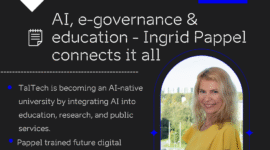Electroactive Polymer (EAP) materials enable a new broad range of applications for which large strains and forces are desirable, and for which built-in intelligence is necessary. It is hoped that MICACT’s research will in turn, facilitate important improvements to multiple areas, including medicine, biomedicine, environmental monitoring, IoT devices and other technologies which already have impact and will even more influence our everyday life in near future. The project is being coordinated by the University of Tartu, of Estonia’s most prestigious HE establishments and the top ranked university of the Baltic region. The research findings led by a local university present a number of exciting possibilities, from making aircraft wings lighter (and therefore more efficient), to creating artificial muscles.
Developing the smart materials of tomorrow
From Estonia to Italy, France to Sweden, Germany, the UK, Spain and the Netherlands, a multidisciplinary team of scientists from across the world, funded by the European Union, is working on the development of hi-tech ‘smart materials’ soon to influence our everyday lives.
Coordinated by Professor Alvo Aabloo of the University of Tartu, MICACT is an ‘Innovative Training Network’ set up with a grant from the EU’s Marie Skłodowska-Curie Actions (MSCA), which have supported more than 110,000 researchers over the past 20 years, including nine Nobel laureates.
The 15 young researchers in the MICACT network are working on the development of so-called Electroactive Polymer (EAP) materials and their integration into real-life applications. EAPs are materials capable of changing dimensions and shape in response to electrical stimuli; they have properties well beyond what conventional metal or plastic-based actuators can offer, including great mechanical flexibility (they can be stretched to twice their initial size), and in most cases, low cost. Applications range from making aircraft wings lighter to creating artificial muscles, with impacts in areas as varied as medicine, robotics and environmental monitoring.
On a technical level, the network has already demonstrated a great deal of innovation, with results recognised in the scientific community that push forward the state of the art in microfabrication technology and material science in the field, achieving breakthroughs that are important both in the scientific field and for their potential business applications by achieving significant reductions in production cost.
But the development of ‘soft skills’ – things like commercialisation, scientific writing, startup building, business accelerators or gender in science – is equally important, while the networking has proved invaluable to the 15 MSCA fellows.
“Having a European network makes our research faster, since we already know each other,” says Italian PhD student Alessandro Ianarelli, studying at Delft University of Technology thanks to MICACT. “We just have to take advantage of this networking and so the communication is made faster and easier… networking is already created, and that helps a lot.”
Tartu is hosting two PhD students from the network – one from neighbouring Latvia, working on microfabrication of polymer-carbon composites, and one from India working on robotic applications. And last year, the University’s Institute of Technology hosted a training school addressing issues from carbon nanotubes to wave energy converters, artificial muscles to soft robotic applications.
“This kind of international workshop is extremely important for the development of Estonian science and industry, because it will contribute to better cooperation with other first-rate centres and universities,” said Professor Aabloo.
At the same time, the project is reaching out to the community. During the training school in Tartu, a half-day outreach session was organised in a local school to demonstrate ‘artificial muscles’ in action, and give the children the opportunity of a small hands-on session in robotics. It was an inspiration for the next generation of young Estonian scientists, tomorrow’s innovators in technologies we cannot even imagine today.
From the series of articles to celebrate Marie Skłodowska-Curie Actions – 20 years of European support for researchers’ work.
More reading https://ec.europa.eu/research/
 Back
Back



